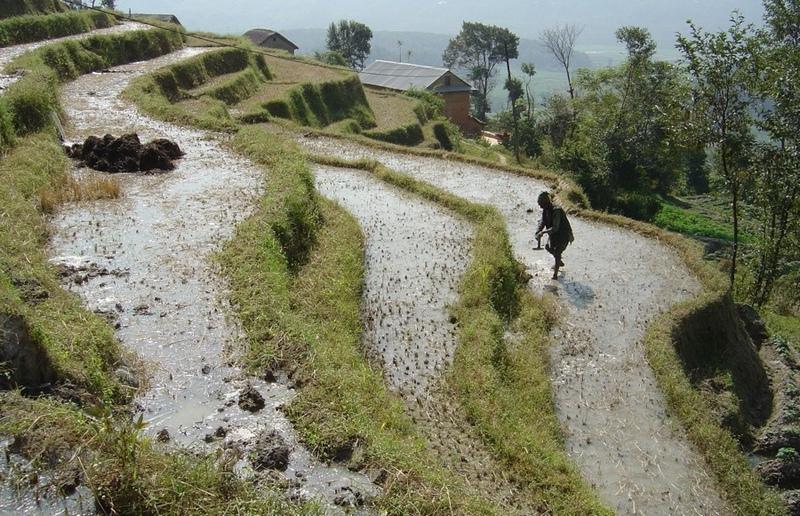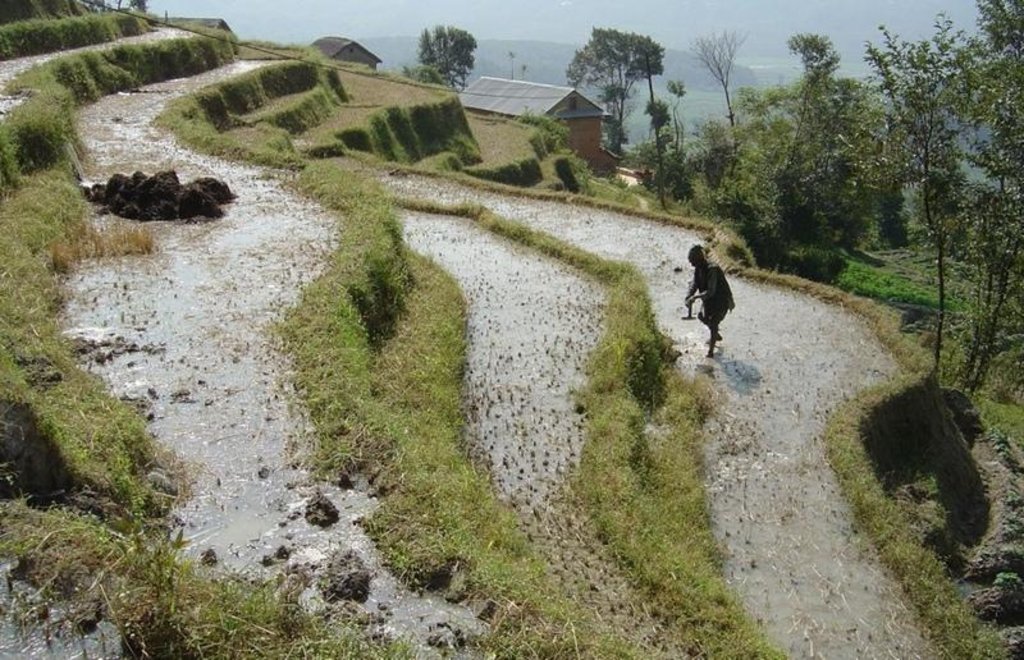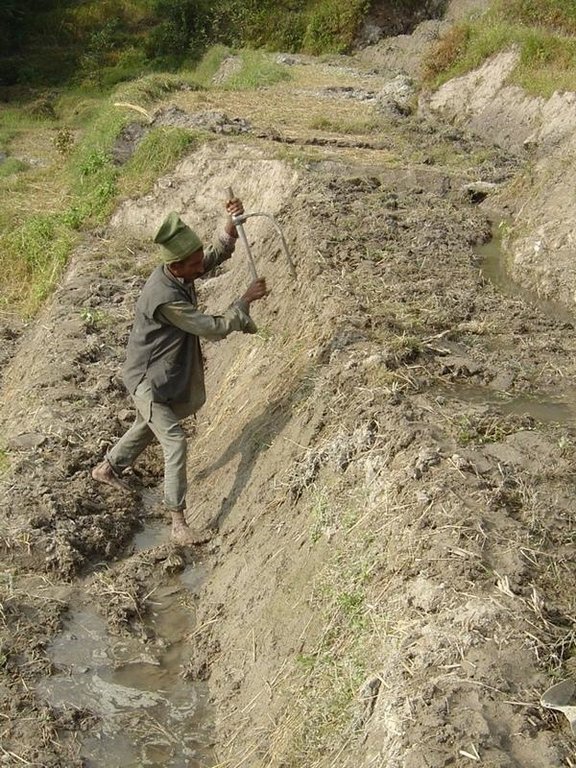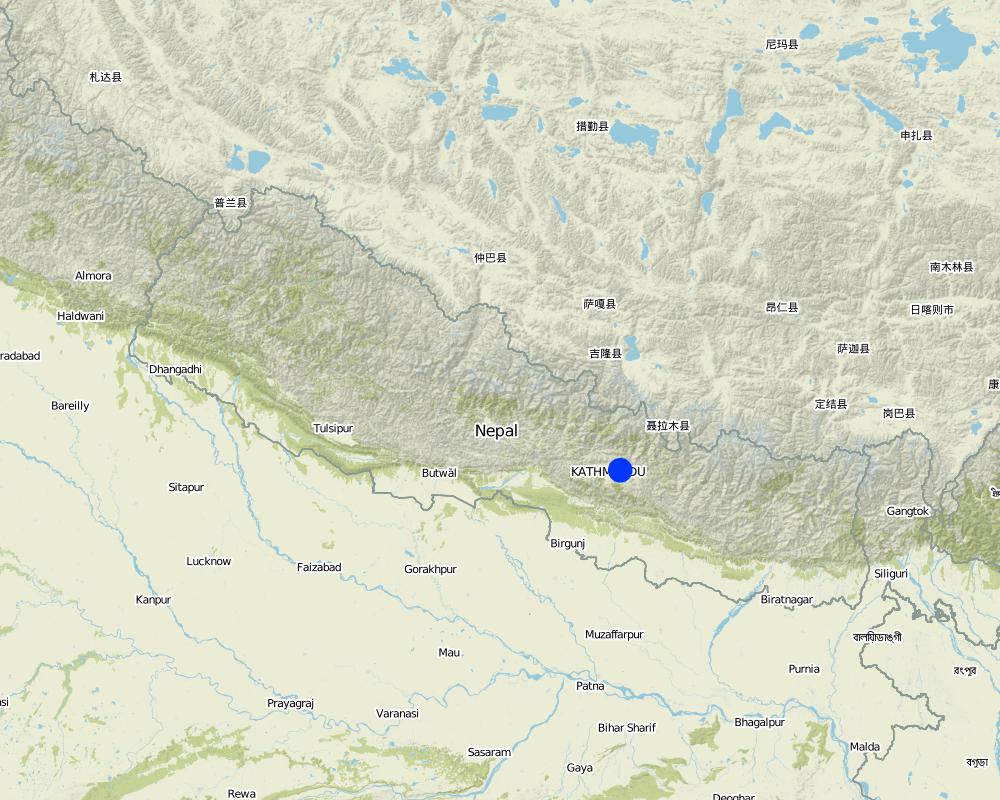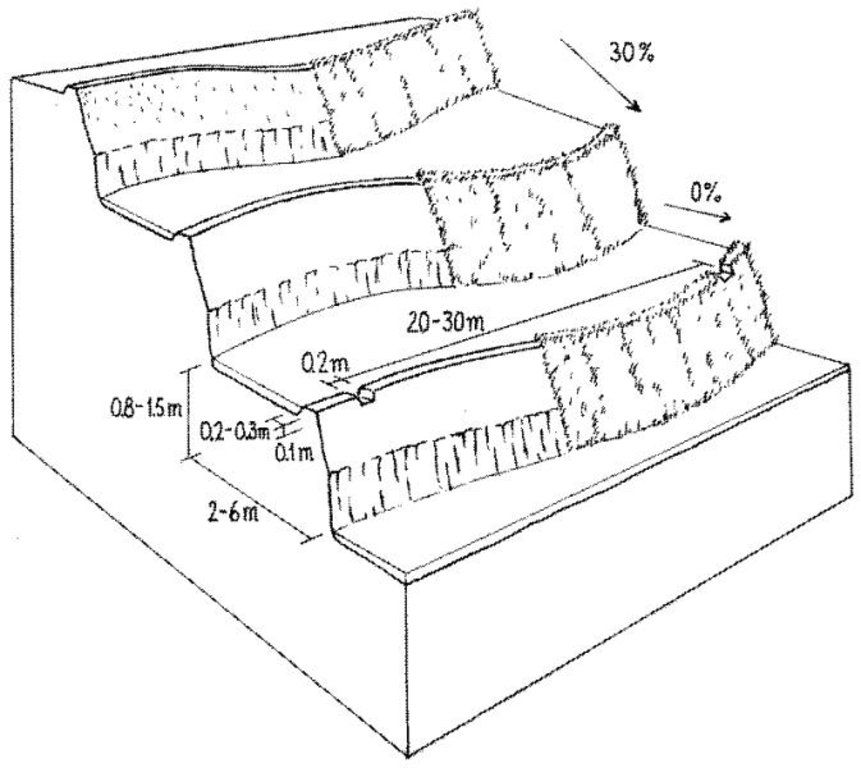Traditional irrigated rice terraces [尼泊尔]
- 创建:
- 更新:
- 编制者: Ramanand Bhattarai
- 编辑者: –
- 审查者: David Streiff, Deborah Niggli, Alexandra Gavilano
Tari khet (Nepali)
technologies_1099 - 尼泊尔
查看章节
全部展开 全部收起1. 一般信息
1.2 参与该技术评估和文件编制的资源人员和机构的联系方式
SLM专业人员:
有助于对技术进行记录/评估的项目名称(如相关)
Book project: where the land is greener - Case Studies and Analysis of Soil and Water Conservation Initiatives Worldwide (where the land is greener)有助于对技术进行记录/评估的机构名称(如相关)
District Soil Conservation Office (DSCO) - 尼泊尔有助于对技术进行记录/评估的机构名称(如相关)
ICIMOD International Centre for Integrated Mountain Development (ICIMOD) - 尼泊尔1.3 关于使用通过WOCAT记录的数据的条件
编制者和关键资源人员接受有关使用通过WOCAT记录数据的条件。:
是
2. SLM技术的说明
2.1 技术简介
技术定义:
Level bench terraces with risers protected by fodder grasses, used for the irrigated production of rice, potatoes and wheat
2.2 技术的详细说明
说明:
The level bench terrace is a traditional technology that makes irrigated crop production possible on steep, erosion prone slopes. The majority of such terraces in Nepal were constructed by hand many generations ago, but some new land - mostly already under rainfed cultivation on forward sloping terraces - is still being converted into irrigated terraces. The initial costs for the construction of the terraces are extremely high – and annual maintenance costs are considerable also. The climate is humid subtropical, slopes are steep (30%-60%) and soils generally have a sandy loam texture. Terraces are cropped by farmers who mostly have less than 0.5 ha of land each.
Two to three annual crops are grown per year starting with paddy rice during the monsoon, followed by potatoes and/or wheat.
While terrace beds are usually 2–6 m in width, to save labour they are made as wide as they can be without increasing the danger of slips/land slides. Surveying was traditionally done by eye, but now a water-tube level may be used. Risers are 0.8-1.5 m high with a small lip (20-25 cm). The slope of the riser varies from 80 to 160%, depending on the initial gradient of the hill. Stones are incorporated in the risers if available, and grass species such as bermuda grass (Cynodon dactylon) and napier (Pennisetum purpureum) may be planted for stabilisation and as cattle fodder. The risers are compacted (with hoes) to improve ponding conditions for the paddy rice. Twice per year the risers are scraped with a special tool: (1) at the time of land preparation for paddy rice the lower part of riser is sliced, but the upper part is left protected with grasses against the monsoon rains; (2) at the time of wheat planting the whole riser (including the lip) is scraped and spread as green manure on the terrace.
Terraces are flooded with water for paddy rice cultivation: a smaller amount of water is diverted into the fields for other crops. Excess water is drained to the lower terrace by openings in the lip, which are filled with rice straw in order to filter out sediments. The depth of water for rice - when flooded completely - is normally between 10 and 15 cm. Fertility is maintained by addition of farmyard manure, spreading the scraped soil from the riser, and also through sediment carried in the irrigation water. Nowadays, mineral fertilizers are also applied.
2.3 技术照片
2.5 已应用该技术的、本评估所涵盖的国家/地区/地点
国家:
尼泊尔
区域/州/省:
Kathmandu
有关地点的进一步说明:
Manmata subwatershed
具体说明该技术的分布:
- 均匀地分布在一个区域
如果技术均匀分布在一个区域,则指定覆盖的区域(单位为平方千米):
1.0
如果不知道精确的区域,请注明大致覆盖的区域:
- 0.1-1 平方千米
注释:
Total area covered by the SLM Technology is 1 km2.
Map
×3. SLM技术的分类
3.1 该技术的主要目的
- 改良生产
3.2 应用该技术的当前土地利用类型

农田
- 一年一作
年作 - 具体指明作物:
- 谷类 - 水稻(湿地)
- 根/块茎作物 - 土豆
- wheat
每年的生长季节数:
- 2
具体说明:
Longest growing period in days: 150 Longest growing period from month to month: Jun - Oct Second longest growing period in days: 120 Second longest growing period from month to month: Nov - Feb
注释:
Major cash crop: Potatoes
Major food crop: Rice and wheat
Major land use problems (compiler’s opinion): - steep slopes, not suitable for agriculture in their original state (better for forestry, agroforestry, horticulture, and fruit
trees)
- small and scattered plots of land
- land users find chemical fertilizers and water expensive
- there is water scarcity from September to May and too much rain in the monsoon period (June to August) with the danger of erosion and collapse of the terraces
3.4 供水
该技术所应用土地的供水:
- 雨养
3.5 该技术所属的SLM组
- 横坡措施
3.6 包含该技术的可持续土地管理措施

农艺措施
- A2:有机质/土壤肥力

植物措施
- V2:草和多年生草本植物

结构措施
- S1:阶地
注释:
Main measures: agronomic measures, vegetative measures, structural measures
Type of agronomic measures: manure / compost / residues, mineral (inorganic) fertilizers
3.7 该技术强调的主要土地退化类型

土壤水蚀
- Wt:表土流失/地表侵蚀
- Wg:冲沟侵蚀/沟蚀
- Wm:块体运动/滑坡
注释:
Main type of degradation addressed: Wt: loss of topsoil / surface erosion, Wg: gully erosion / gullying, Wm: mass movements / landslides
3.8 防止、减少或恢复土地退化
具体数量名该技术与土地退化有关的目标:
- 防止土地退化
4. 技术规范、实施活动、投入和成本
4.1 该技术的技术图纸
技术规范(与技术图纸相关):
Layout of irrigated terraces. Openings in the lips drain excess water, grass cover stabilises lips and risers (right). After harvesting of rice, the grass is scraped off the lower part of the risers (left) and spread on the terrace beds
Technical knowledge required for field staff / advisors: high
Technical knowledge required for land users: high
Main technical functions: reduction of slope angle, reduction of slope length, increase / maintain water stored in soil, control of dispersed and concentrated runoff, increase in soil fertility
Secondary technical functions: improvement of ground cover, water harvesting / increase water supply, water spreading
Manure / compost / residues
Material/ species: green/farmyard manure
Vegetative measure: fodder grass at risers
Terrace
Material: earth
作者:
Mats Gurtner
4.2 有关投入和成本计算的一般信息
具体说明成本和投入是如何计算的:
- 每个技术区域
注明尺寸和面积单位:
ha
具体说明成本计算所用货币:
- 美元
4.3 技术建立活动
| 活动 | 时间(季度) | |
|---|---|---|
| 1. | Planting grasses including bermuda grass (Cynodon dactylon). | during monsoon |
| 2. | Construct bunds (risers) with soil from upper and lower sides | before monsoon |
| 3. | Level terrace beds (soil moved from upper to lower part of terraces). | before monsoon |
| 4. | Make lips on edges of terraces | before monsoon |
| 5. | Compact risers | before monsoon |
| 6. | Construct irrigation canal | before monsoon |
| 7. | Make openings in lips for drainage of excess water | before monsoon |
| 8. | Test-irrigate terrace for accurate levelling | during monsoon |
| 9. | Plant grasses including Bermuda grass (Cynodon dactylon) | during monsoon |
| 10. | After 2–3 years: some narrow terraces may be merged to form single, wider terraces | during monsoon |
4.5 维护/经常性活动
| 活动 | 时间/频率 | |
|---|---|---|
| 1. | Flood the paddy fields .. | (June/July) / Repeated 3–4 times during |
| 2. | Slice/scrape grass and soil on lower part of risers and spread on terraces | (when flooded, June/July) / |
| 3. | Plant rice and apply mineral fertilizer | (June/July). / |
| 4. | Harvest rice | (October) / |
| 5. | Apply manure (cattle manure), after rice harvest | (October). / |
| 6. | Slice/scrape grass and soil from whole of risers and spread on terraces; repairsmall collapses/slumps in risers | (October/November) / |
| 7. | Pprepare land | (November) / |
| 8. | Apply mineral fertilizer | (November/December). / |
| 9. | Irrigate | Nov. / repeated several times during cultivation |
| 10. | Harvest of potato/wheat | (January-March). / |
| 11. | Planting of rice | June,July / |
| 12. | planting of potatoes, wheat | November / |
| 13. | Repair of small collapses/slumps in risers. | (Oct./Nov.)/ |
4.6 维护/经常性活动所需要的费用和投入(每年)
| 对投入进行具体说明 | 单位 | 数量 | 单位成本 | 每项投入的总成本 | 土地使用者承担的成本% | |
|---|---|---|---|---|---|---|
| 劳动力 | Labour | ha | 1.0 | 350.0 | 350.0 | 100.0 |
| 设备 | Tools | ha | 1.0 | 5.0 | 5.0 | 100.0 |
| 肥料和杀菌剂 | Fertilizer | ha | 1.0 | 185.0 | 185.0 | 100.0 |
| 肥料和杀菌剂 | Compost/manure | ha | 1.0 | 300.0 | 300.0 | 100.0 |
| 技术维护所需总成本 | 840.0 | |||||
| 技术维护总成本,美元 | 840.0 | |||||
注释:
Machinery/ tools: hoe, spade, baskets, (doko), special tool for scraping
Current establishment costs are very difficult to determine since the majority of the traditional terraces were
established a long time ago. Costs depend closely on the present state of the land (forward sloping terraces or uncultivated) and the need for irrigation canals. Farmers say that construction now could cost up to US$ 10,000 per ha if carried out by hand at full labour cost. The cost given for maintening the terraces (approx. US$ 840 per ha) includes all associated annual crop production costs. In this case study, 100% of the construction costs were borne by land users.
5. 自然和人文环境
5.1 气候
年降雨量
- < 250毫米
- 251-500毫米
- 501-750毫米
- 751-1,000毫米
- 1,001-1,500毫米
- 1,501-2,000毫米
- 2,001-3,000毫米
- 3,001-4,000毫米
- > 4,000毫米
农业气候带
- 潮湿的
Thermal climate class: subtropics
5.2 地形
平均坡度:
- 水平(0-2%)
- 缓降(3-5%)
- 平缓(6-10%)
- 滚坡(11-15%)
- 崎岖(16-30%)
- 陡峭(31-60%)
- 非常陡峭(>60%)
地形:
- 高原/平原
- 山脊
- 山坡
- 山地斜坡
- 麓坡
- 谷底
垂直分布带:
- 0-100 m a.s.l.
- 101-500 m a.s.l.
- 501-1,000 m a.s.l.
- 1,001-1,500 m a.s.l.
- 1,501-2,000 m a.s.l.
- 2,001-2,500 m a.s.l.
- 2,501-3,000 m a.s.l.
- 3,001-4,000 m a.s.l.
- > 4,000 m a.s.l.
5.3 土壤
平均土层深度:
- 非常浅(0-20厘米)
- 浅(21-50厘米)
- 中等深度(51-80厘米)
- 深(81-120厘米)
- 非常深(> 120厘米)
土壤质地(表土):
- 粗粒/轻(砂质)
- 中粒(壤土、粉土)
表土有机质:
- 中(1-3%)
如有可能,附上完整的土壤描述或具体说明可用的信息,例如土壤类型、土壤酸碱度、阳离子交换能力、氮、盐度等。:
Soil fertility is medium
Soil drainage / infiltration is good because of the geology and soil texture (loam)
5.6 应用该技术的土地使用者的特征
生产系统的市场定位:
- 混合(生计/商业)
非农收入:
- 收入的10-50%
个人或集体:
- 个人/家庭
机械化水平:
- 手工作业
- 畜力牵引
说明土地使用者的其他有关特征:
Off-farm income specification: hired labour (on other farmers’ fields) or as porters
Market orientation of production system: Subsistence (rice/wheat) and commercial (potatoes)
5.7 应用该技术的土地使用者使用的平均土地面积
- < 0.5 公顷
- 0.5-1 公顷
- 1-2 公顷
- 2-5公顷
- 5-15公顷
- 15-50公顷
- 50-100公顷
- 100-500公顷
- 500-1,000公顷
- 1,000-10,000公顷
- > 10,000公顷
5.8 土地所有权、土地使用权和水使用权
土地所有权:
- 个人,未命名
土地使用权:
- 租赁
- 个人
注释:
Land use rights: leased (90% of farmers), individual (10%)
6. 影响和结论性说明
6.1 该技术的现场影响
社会经济效应
生产
作物生产
饲料生产
饲料质量
生产区域
土地管理
注释/具体说明:
the technology is a part of a complex farming system
收入和成本
农业投入费用
农业收入
经济差异
注释/具体说明:
not everyone has access to land for irrigation
工作量
其它社会经济效应
Livestock fodder
社会文化影响
社区机构
SLM/土地退化知识
冲突缓解
注释/具体说明:
when the agreed and scheduled water extraction amounts are exceeded
生态影响
水循环/径流
多余水的排放
土壤
土壤水分
土壤覆盖层
土壤流失
减少气候和灾害风险
滑坡/泥石流
注释/具体说明:
poor maintenance of topmost terraces may cause landslides
其它生态影响
Soil fertility
Biodiversity
Number of crabs in irrigation water make holes in the terrace risers
注释/具体说明:
which in turn can cause pipe erosion and riser collapse
6.2 该技术的场外影响已经显现
旱季稳定可靠的水流
下游洪水
下游淤积
地下水/河流污染
Groundwater recharge
Soil moisture and nutrients downstream
6.3 技术对渐变气候以及与气候相关的极端情况/灾害的暴露和敏感性(土地使用者认为的极端情况/灾害)
渐变气候
渐变气候
| 季节 | 增加或减少 | 该技术是如何应对的? | |
|---|---|---|---|
| 年温度 | 增加 | 好 |
气候有关的极端情况(灾害)
气象灾害
| 该技术是如何应对的? | |
|---|---|
| 局地暴雨 | 不好 |
| 局地风暴 | 不好 |
气候灾害
| 该技术是如何应对的? | |
|---|---|
| 干旱 | 不好 |
水文灾害
| 该技术是如何应对的? | |
|---|---|
| 比较和缓的(河道)洪水 | 不好 |
其他气候相关的后果
其他气候相关的后果
| 该技术是如何应对的? | |
|---|---|
| 缩短生长期 | 不好 |
6.4 成本效益分析
技术收益与技术建立成本相比如何(从土地使用者的角度看)?
短期回报:
非常消极
长期回报:
积极
技术收益与技术维护成本/经常性成本相比如何(从土地使用者的角度看)?
短期回报:
积极
长期回报:
非常积极
6.5 技术采用
在所有采用这项技术的人当中,有多少人是自发的,即未获得任何物质奖励/付款?:
- 91-100%
注释:
100% of land user families have adopted the Technology without any external material support
6.7 该技术的优点/长处/机会
| 编制者或其他关键资源人员认为的长处/优势/机会 |
|---|
|
Income and production increased How can they be sustained / enhanced? Proper management of the terraces (including all maintenance activities) |
| Easier to cultivate flat terraces/less labour required (after establishment of terraces) |
|
Work sharing: traditional terraces are part of a long tradition of work sharing within the community with no external labourneeded How can they be sustained / enhanced? Prevent loss of well established traditions and norms |
|
Technology is easy to understand/apply. Increased opportunities for irrigation facilities: farmers without level terraces are not allowed (by the irrigation committee at village level) or do not claim irrigation water |
|
The irrigation element of this technology fosters social bonds within the community How can they be sustained / enhanced? Prevent loss of well established norms and traditions. |
6.8 技术的弱点/缺点/风险及其克服方法
| 编制者或其他关键资源人员认为的弱点/缺点/风险 | 如何克服它们? |
|---|---|
| Decreased grass production (grazing area reduced) | Promote planting of high value grass species on risers (such as bermuda grass). |
| The farmers believe that the terraces are too narrow (for efficient use of tractors); they would like to have wider terraces |
Investigate possibilities of constructing wider paddy rice terraces on steep slopes, which, according to present experience, is not possible. |
| High labour costs for establishment. |
7. 参考和链接
7.1 信息的方法/来源
7.2 参考可用出版物
标题、作者、年份、ISBN:
There is considerable literature on the construction and maintenance of irrigated terraces in general, but no references thatspecifically describe the traditional paddy rice terraces in Nepal
链接和模块
全部展开 全部收起链接
无链接
模块
无模块


